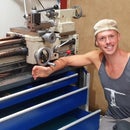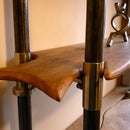Introduction: Fixing Twist in a Slab or Board
Solid wood. You can't beat it for aesthetic appeal. It can stimulate all our senses and generally rocks as a material to furnish everyday life. But with that great power comes great potential for warpage! It's one of the reasons mass-market makers who are all about the bottom line shy away from it in favour of 'manufactured boards'. The natural movement in solid timber can require a lot of experience and knowledge to control. This 'able is about learning to deal with that power, by fixing twist.
'Twist' is the most difficult flavour of warpage to deal with, so lets get started. We are going to be using the little talked of 'de-stressing and strategic weakening' method!
Step 1: Establishing Your Twistedness
To check for twist, make yourself some winding sticks. These are as simple and two lengths of equal-sized wood. Contrasting types of wood work well to highlight twist, but you can also use the same wood and paint one a different colour. Their main requirement is that they are flat, straight, and the same thickness, so that holding one in front of the other, the back one completely vanishes from sight.
To get a handle on the extent of twist a board has, place a winding stick either end and look down the length of the slab. If the far stick isn't visible because it is perfectly lined up with with the closest one, congratulations, you don't have twist. If however, as in our example, a portion of it is still in view, your slab is twisted, or 'in-wind' as the old timers like to say.
You can do a similar test with a spirit level, comparing the level at points along the board, but the beauty of the winding sticks, is that you can use them anywhere - even if the whole board is off level.
Step 2: Ripping, Face Removal, Clamping
They sound gruesome, but they're not.
You have a lot of options when it comes to dealing with twist in a board and your choice will depend on the severity of the twist, the type and size of wood you are dealing with, how you're feeling at the time, weather or not you had ice in your drink etc. I'll list the main ones I consider practical:
1. Ripping. This is a good option if you have a wide board that is both twisted and cupped. Essentially this involves ripping it down the middle with a tracksaw, a bandsaw or even a handsaw(!?) to make two or more smaller boards, which, once squared up can be glued back together straight. The upside is that you are removing less material than if you go with option #2, just the width of the saw's blade - its kerf - and whatever you need to plane off to square the edges. The down side is that even with that little removal, you will loose your nice continuous grain pattern, which will be broken by glue lines. Ironically the boards that are worst affected by this, in which the break in grain is most apparent, are the characterful swirly grain boards that are also the most likely to suffer from twist or warp of some kind.
2. Face removal, or removal of material from the face of the board, can be an option if the amount of twist is less than the thickness of the board. This can be done cave-man style using scrub and jack planes, or with power planers (either hand held or the stationary jointer or thicknesser). If the board it too wide to fit through the thicknesser, it can also be done with a diy router sled - see my coffee table instructable here, for example. The advantage of this method is that you can be left with a complete and solid single piece flat slab. The disadvantage is that it can only really correct minor twist without sacrificing a lot of thickness. Furthermore, removing lots of material can often, lead to what I call 'aftershock-warpage', as internal stresses are changed, and moisture lost from the freshly exposed surfaces.
3. Clamping. This is useful when the board is part of a larger assembly. If, for example, you have a strong frame to fix the twisted slab to it is sometimes possible to 'clamp out' most or all of the twist. Here you are relying on the strength of the rest of the assembly to overpower the slab and pull it flat. Obviously this means the frame needs to be stiffer than the slab your trying to bend into shape. If you can get away with using this solution, it can be the best because it mitigates the disadvantages of the previous two options, namely, you can keep more of the thickness (less waste) and keep it one piece. The problem is that if you have a thick slab you need a very sturdy frame or you risk distorting the whole piece of furniture. If the slab is stubborn you also risk causing splits as you introduce the clamping forces. Much of the rest of this instructable deals with this method, and how to pull it off.
4. Ditch the slab and start with a new straight one. Not an attractive option.
5. Combo. There is nothing to stop you using a combination of some or all of these techniques. In my example the slab was ripped down the middle, both pieces being planed flat, then re-glued. Yet when it spent some time in its final destination it still did some twisting due to the dryness of that environment. On site it was preferable to clamp the twist out, but the frame wasn't up to the job, and I would likely cause the slab to crack if I pushed it.. This leads me to the crux of this instructable: de-stressing the slab and strategic weakening!
Step 3: De-stressing a Slab - the Theory
By cutting part-depth channels along the length of a board we can strategically weaken it in places that will make it more amenable to our re-shaping efforts. Check out the pics for example. The trick here is to add relief to places that are in compression, that way when you bend the board, the remaining material has to move less. It is also much easier to bend across its width, so your frame doesn't need to be ridiculously strong.
Obviously the pics are an exaggerated example. What you want to do is remove as little material as possible (fewer and shallower cuts), while making it susceptible to being bent, or un-bent, in the directions you need. Strategic removal is the aim.
Step 4: Strategically Weakening - in Practice
This is only going to work in situations where one face is going to be hidden, unless you want to add inlay, or laminate another piece of timber or veneer over the channels (which is totally acceptable - I've used this method in the past, make a feature out of it why not?). In the example we are working through I am using a plungable tracksaw to cut the channels length-ways along the slab. You could also use a small router bit, or with care, a standard circular saw. What you couldn't/shouldn't use is a tablesaw or sawbench. In fact you shouldn't ever use the tablesaw with a twisted board - it's very likely to bind and kickback (dangerous!).
I'm cutting about 2/3 to 3/4 of the way through this sycamore slab. The depth and number of cuts will depend on just how warped the board is, and how likely it is to crack if you use the frame to pull out the twist. Avoid cutting near defects that look like they might propagate into larger cracks. Remember the buzzword is strategic weakening.
Thankfully the channels I'm cutting shouldn't reduce longitudinal strength much. But it does make it much more willing to be un-twisted when we come to fix it to the frame (rather than it distorting the frame).
Step 5: Clamping Methods (on Holding It Flat)
Hopefully it goes without saying the when you come to fix your slab to a frame, it needs to accommodate future movement of the slab. It will move most across the grain so in the frame you need slots rather than holes for the screws.
Small pilot holes are useful when screwing into a hardwood slab like this. It's good to clamp it in place and check it is indeed now flattened, before drilling through the middle of the frame's slot into the slab. Then screw on up to fix it.
Step 6: Conclusion
Hopefully some of that was useful. This method can be a lifesaver if you can't afford to take any more off the thickness of your board.
Let me know if you have used it / do use it/ have any improvements.
As always thanks for reading and check out my latest tinkerings on facebook or my youtube channel.
May your winding sticks always line up!











